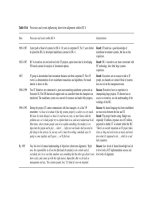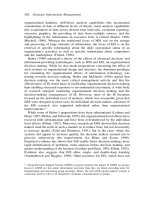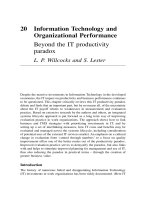Managing information systems 7th edition brow ch03
Bạn đang xem bản rút gọn của tài liệu. Xem và tải ngay bản đầy đủ của tài liệu tại đây (608.7 KB, 49 trang )
MANAGEMENT INFORMATION SYSTEMS
CHAPTER 3
TELECOMMUNICATIONS AND NETWORKING
Copyright © 2011 Pearson Education, Inc. publishing as Prentice Hall
3-1
PART 1: IT BUILDING BLOCKS
Copyright © 2011 Pearson Education, Inc. publishing as Prentice Hall
3-2
NETWORKING AND TELECOMMUNICATIONS
.
NETWORKING:
The electronic linking of geographically dispersed devices
TELECOMMUNICATIONS:
Communications at a distance, including voice and data
- Also referred to as: data communications, datacom,
teleprocessing, telecom, and networking
Copyright © 2011 Pearson Education, Inc. publishing as Prentice Hall
3-3
OVERVIEW OF TELECOMMUNICATIONS AND NETWORKING
•
Telecommunications and networking have become increasingly important to businesses because of
distributed processing and globalization
Copyright © 2011 Pearson Education, Inc. publishing as Prentice Hall
3-4
THE TELECOMMUNICATIONS INDUSTRY
Three Major Segments of Telecom Industry:
•
Carriers who own or lease physical plant & sell the service of communications transmission
•
Equipment vendors who manufacture and sell telecommunications equipment
•
Service providers who operate and deliver network services or provide access to or deliver
services via the Internet
Copyright © 2011 Pearson Education, Inc. publishing as Prentice Hall
3-5
THE TELECOMMUNICATIONS INDUSTRY
Example: AT&T
•
One of largest carriers in U.S. industry
•
In 1984, AT&T split into several companies as a result of a US Department of Justice
antitrust lawsuit
•
Breakup of AT&T led to greater innovation through competition
•
But recent trend has been consolidation in the industry
Copyright © 2011 Pearson Education, Inc. publishing as Prentice Hall
3-6
REASONS FOR NETWORKING
Five primary reasons for networking
1.
2.
3.
4.
5.
Sharing of technology resources
Sharing of data
Distributed data processing and client/server systems
Enhanced communications
Marketing outreach
Copyright © 2011 Pearson Education, Inc. publishing as Prentice Hall
3-7
REASONS FOR NETWORKING
1. Sharing of technology resources:
•
•
Prior to networking capabilities, computers could not even share printers….
Today, PCs share software, mainframes share storage devices, etc.
2. Sharing of data:
•
•
•
•
Enables retrieval of data stored on other nodes in the network
Allows efficient transactions between businesses, their suppliers, and their customers, based on up-to-date data
Some businesses share many terabytes of data per day
Sharing of data via Internet users
Copyright © 2011 Pearson Education, Inc. publishing as Prentice Hall
3-8
REASONS FOR NETWORKING
3. Distributed data processing and client/server systems:
Distributed data processing
•.
Information processing that uses multiple computers at multiple sites that are tied together through
telecommunication lines
Client/server systems
•.
A type of distributed system in which the processing power is distributed between a central server and a number of
client computers
Client
Copyright © 2011 Pearson Education, Inc. publishing as Prentice Hall
Transfer of Data
Server
3-9
REASONS FOR NETWORKING
4. Enhanced communications:
•
Telecommunication networks provide the ability to communicate through Email, Bulletin Boards, Blogs, Instant
Messaging, Wikis, Social network sites, Videoconferencing
•
Links between organizations can lead to strategic alliances
o
o
SABRE airline reservation system
Electronic data interchange (EDI)
5. Marketing outreach:
•
Sharing data via the Internet with consumers = an important marketing and sales channel
Copyright © 2011 Pearson Education, Inc. publishing as Prentice Hall
3-10
FUNCTIONS OF A TELECOMMUNICATIONS NETWORK
•
A telecommunications network is more than a series of wires or wireless signals…
Table 3.1
Copyright © 2011 Pearson Education, Inc. publishing as Prentice Hall
3-11
ANALOG AND DIGITAL SIGNALS
•
Analog Signals
A signal in which some physical property continuously varies across time
•
Digital Signals
A signal that is not a continuous function of time, but rather a series of discrete values that represent
ones and zeros
Copyright © 2011 Pearson Education, Inc. publishing as Prentice Hall
3-12
ANALOG AND DIGITAL SIGNALS
•
Representation of digital and analog signals
Copyright © 2011 Pearson Education, Inc. publishing as Prentice Hall
3-13
ANALOG AND DIGITAL SIGNALS
•
Digital computer data does not naturally mesh with analog transmission; it must be converted from
ones and zeros to analog signals
•
Solutions:
•
Modem (Modulator/Demodulator)
•
Digital networks
Advantages of lower error rates and higher speeds
•
Copyright © 2011 Pearson Education, Inc. publishing as Prentice Hall
3-14
TYPES OF TRANSMISSION LINES
Private (dedicated physical lines)
•
Advantage:
- Ensures quality of transmission
•
Disadvantage:
-
Costly
Switched (such as public telephone network)
•
Advantage:
- Less costly
•
Disadvantages:
- Message may take many different routes
- Quality of transmission may degrade
Copyright © 2011 Pearson Education, Inc. publishing as Prentice Hall
3-15
TYPES OF TRANSMISSION LINES
•
Simplex
Data can only travel in one direction
•
Half Duplex
Data can travel in both directions, but not simultaneously
•
Full Duplex
Data can travel in both directions at once
Copyright © 2011 Pearson Education, Inc. publishing as Prentice Hall
3-16
TRANSMISSION MEDIA
Twisted Pair
•
•
•
•
Literally, wires that are twisted to reduce interference
Can be shielded (STP) or unshielded (UTP), but the most commonly used is UTP
Medium used for public telephone networks
Transmission speeds vary greatly
Copyright © 2011 Pearson Education, Inc. publishing as Prentice Hall
3-17
TRANSMISSION MEDIA
Coaxial (Coax) Cable
•
Baseband
- Inexpensive, designed for digital transmission
•
Broadband
- Originally for analog, now used for digital
- Commonly used in television cable
Figure 3.2
Copyright © 2011 Pearson Education, Inc. publishing as Prentice Hall
3-18
TRANSMISSION MEDIA
Wireless
•
•
•
Not truly a transmission medium, but rather a broadcast technology in which radio signals are sent
through the air
Cordless telephones and cellular telephones now widely used
Wireless technologies:
•
•
Wireless LANs
•
Satellite
•
•
RFID
Microwave
– Line of sight
– Long distances
– Line of sight
Bluetooth
Wireless Cards
Copyright © 2011 Pearson Education, Inc. publishing as Prentice Hall
3-19
TRANSMISSION MEDIA
Wireless
•
Wireless LANs
- Growing in popularity
- Useful when wiring is not possible
- Slower than some wired solutions
- Allow mobile devices to connect to network
Copyright © 2011 Pearson Education, Inc. publishing as Prentice Hall
3-20
TRANSMISSION MEDIA
Wireless
•
Microwave
- Widespread use for several decades
- Line of sight transmission
- Limited to 25-50 mile distances because of curvature of the earth
- Expensive, but less costly than fiber optic cables
Microwave Tower
Copyright © 2011 Pearson Education, Inc. publishing as Prentice Hall
3-21
TRANSMISSION MEDIA
Wireless
•
Satellite
1.
Geostationary Earth Orbit (GEO)
- Remains stationary relative to earth
2.
Low Earth Orbit ( LEO)
- 400 to 1000 miles above earth
Figure 3.3
Copyright © 2011 Pearson Education, Inc. publishing as Prentice Hall
3-22
TRANSMISSION MEDIA
LEO projects beginning in 1990s
•
Iridium
-
First major LEO project with 66 satellites
-
Faced high operating costs which resulted in bankruptcy
-
Mostly military subscribers
•
Globalstar
-
LEO project with 40 satellites that does not provide global coverage
•
Teledesic
- Ambitious project with original plans to launch 840 satellites
- This was later cut to 288 satellites, then 30, and then the program was cancelled
Copyright © 2011 Pearson Education, Inc. publishing as Prentice Hall
3-23
TRANSMISSION MEDIA
Wireless
•
RFID
- Acronym for Radio Frequency Identification
- An old technology that became popular in business after Wal-Mart required the use of RFID by
some of its suppliers to improve inventory and supply chain management
Wal-Mart and RFID
Wal-Mart CIO on RFID
Wal-Mart gets tough with suppliers about RFID
Copyright © 2011 Pearson Education, Inc. publishing as Prentice Hall
3-24
TRANSMISSION MEDIA
Wireless
•
RFID
•
Two Broad Types of RFID tags:
- Active – these tags have their own power supply and can transmit messages continuously, on request, or on
a schedule
Cost over $1.00
- Passive – these tags only send a response to an incoming radio signal
Cost in the $0.08 - $0.20 range
Copyright © 2011 Pearson Education, Inc. publishing as Prentice Hall
3-25









